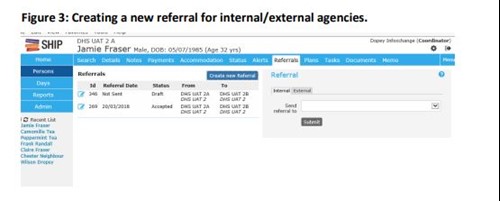Specialist Homelessness Data Collection
 All homelessness services are required to participate in the national SHIP (Specialist Homelessness Information Platform) data system, run by the Australian Institute of Health and Welfare.
All homelessness services are required to participate in the national SHIP (Specialist Homelessness Information Platform) data system, run by the Australian Institute of Health and Welfare.
Guidelines to SHIP can be found at: https://www.aihw.gov.au/about-our-data/our-data-collections/specialist-homelessness-services-collection/specialist-homelessness-information-platform
E-referral
The Homelessness Sector was reformed between 2008 and 2011, largely in response to consumer feedback that the Sector was difficult to navigate. One issue that clients identified was that they were ‘telling their story’ too often.
E-referral has been created as a mechanism to:
- Help homelessness workers create a more seamless service system for clients by enabling sharing of client information, with their consent.
- Save time for homelessness workers – e-referral will create creates and auto populates clients files and enables download of documents.
- Increase security of information for access/entry points sending referrals to homelessness services and for homelessness services to forward updates to access/entry point or to other homelessness services.
E-referral has been operational in SHIP and SRS since 2018. E-referral capacity has now been incorporated into SAMIS.
You can access e-referral training videos from the ‘go live’ information session here:
- Overview session - https://bit.ly/eReferral-Overview
- Demonstration session - https://bit.ly/eReferral-Demonstration

Vacancy Management System
 In 2020 a vacancy management system was built into the SHIP data system for Victorian Homelessness Services. Non SHIP users are allocated access to the Vacancy Management System, independent of SHIP.
In 2020 a vacancy management system was built into the SHIP data system for Victorian Homelessness Services. Non SHIP users are allocated access to the Vacancy Management System, independent of SHIP.
The Vacancy Management System is a key tool for the coordinated homelessness service system as it provides transparency, for homelessness workers, about all the available resources in the system and enables access point workers to 'best match' clients to available resources.
Creating a prioritisation profile
 The SHIP prioritisation profile can by used by access point services and support providers to create a prioritisation list create a list of a specific group of consumers. This function is used by the access point services to develop a 'prioritisation list' of consumers waiting for referral to homelessness services and by services providing IR2/Brief Task Based Response.
The SHIP prioritisation profile can by used by access point services and support providers to create a prioritisation list create a list of a specific group of consumers. This function is used by the access point services to develop a 'prioritisation list' of consumers waiting for referral to homelessness services and by services providing IR2/Brief Task Based Response.
The attached document provides screen shots and an explanation for how to set up the prioritisation profile. Many of the fields will auto populate from the consumer's support period file in SHIP.
Data is one of the key advocacy tools available to the homelessness sector. Below is an information sheet about some of the key data fields to focus on to inform advocacy activities.
Data for advocacy
Data is one of the key advocacy tools available to the homelessness sector. Below is an information sheet about some of the key data fields to focus on to inform advocacy activities.

